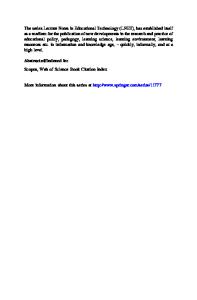Applying the Medical Model to Psychiatric History-Taking: A Teaching Approach that Addresses Learner Stigma
- PDF / 161,087 Bytes
- 2 Pages / 595.276 x 790.866 pts Page_size
- 47 Downloads / 324 Views
LETTER TO THE EDITOR
Applying the Medical Model to Psychiatric History-Taking: A Teaching Approach that Addresses Learner Stigma Morgan M. Medlock 1 Received: 22 April 2020 / Accepted: 31 May 2020 # Academic Psychiatry 2020
To the Editor: Teaching psychiatry to third-year medical students can be challenging, especially when stigma impacts learner enthusiasm and views of the field [1–3]. In my early career as core teaching faculty, some students have shared their belief that psychiatry is unscientific, lacks rigor, and is not based on observable facts (the assumption being that observable facts do not include a person’s mental status but must involve a laboratory or radiographic test of some sort). Several learners have admitted that they view their psychiatric rotation as a break from other learning experiences that seem more investigative and principled. Such attitudes may lead to reluctance to enter the field of psychiatry, thus worsening the shortage of mental health providers in the USA [4]. In response to these concerns, I have developed a teaching approach that underscores similarities between standard medical techniques and the soft skills of psychiatric assessment and diagnosis. In my supervision of medical students and residents, I have noted that those who struggle to see how psychiatry fits into a scientific and logic-based rubric may also develop an idiosyncratic approach to psychiatric assessment that only reinforces their stigma. For example, the psychiatric interview may be reported as a colloquial narrative rather than a clear progression of symptoms that lead to a justifiable mental health diagnosis. Within the psychiatry clerkship curriculum, I facilitate a 90-min seminar entitled “Classification of Psychiatric Disorders in DSM-5.” I discuss the psychiatric assessment utilizing universal terms in medicine, including the “anatomy” of a psychiatric diagnosis, where I explain the core features of mental health disorders, as explained in the Diagnostic and Statistical Manual of Mental Disorders, Fifth Edition (DSM-
* Morgan M. Medlock [email protected] 1
Howard University College of Medicine, Washington, DC, USA
5). I also refer to the mnemonic, “M-A-P-S,” and correlate it to the medical review of systems that follows the History of Present Illness. I emphasize the importance of asking all patients about Mood, Anxiety, Psychosis, and Substance Use, irrespective of their chief complaint. I point out that this rubric also applies across practice settings— whether primary care or behavioral health. The most critical component of this diagnostic training is a conversation on medical versus psychiatric symptoms. Of course, as psychiatry faculty, I see no distinction between medical and psychiatric concerns, but I use this dichotomy to meet learners where they are—recognizing that this stigma certainly exists. I frame the discussion by asking learners how they would evaluate a medical complaint of “pain” compared with a psychiatric complaint of “distress.” I remind them of a well-known framewor
Data Loading...











